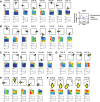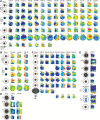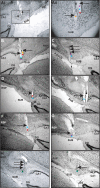Boundary vector cells in the subiculum of the hippocampal formation
- PMID: 19657030
- PMCID: PMC2736390
- DOI: 10.1523/JNEUROSCI.1319-09.2009
Boundary vector cells in the subiculum of the hippocampal formation
Abstract
"Boundary vector cells" were predicted to exist by computational models of the environmental inputs underlying the spatial firing patterns of hippocampal place cells (O'Keefe and Burgess, 1996; Burgess et al., 2000; Hartley et al., 2000). Here, we report the existence of cells fulfilling this description in recordings from the subiculum of freely moving rats. These cells may contribute environmental information to place cell firing, complementing path integrative information. Their relationship to other cell types, including medial entorhinal "border cells," is discussed.
Figures




Comment in
-
Are the boundary-related cells in the subiculum boundary-vector cells?J Neurosci. 2009 Oct 28;29(43):13429-31. doi: 10.1523/JNEUROSCI.4176-09.2009. J Neurosci. 2009. PMID: 19864554 Free PMC article. No abstract available.
References
Publication types
MeSH terms
Grants and funding
- 082507/WT_/Wellcome Trust/United Kingdom
- G01342X/1/BB_/Biotechnology and Biological Sciences Research Council/United Kingdom
- G0501672(76328)/MRC_/Medical Research Council/United Kingdom
- BB/G01342X/1/BB_/Biotechnology and Biological Sciences Research Council/United Kingdom
- G0501672/MRC_/Medical Research Council/United Kingdom
LinkOut - more resources
Full Text Sources
Other Literature Sources
Molecular Biology Databases
